The Reunion of Old Friends
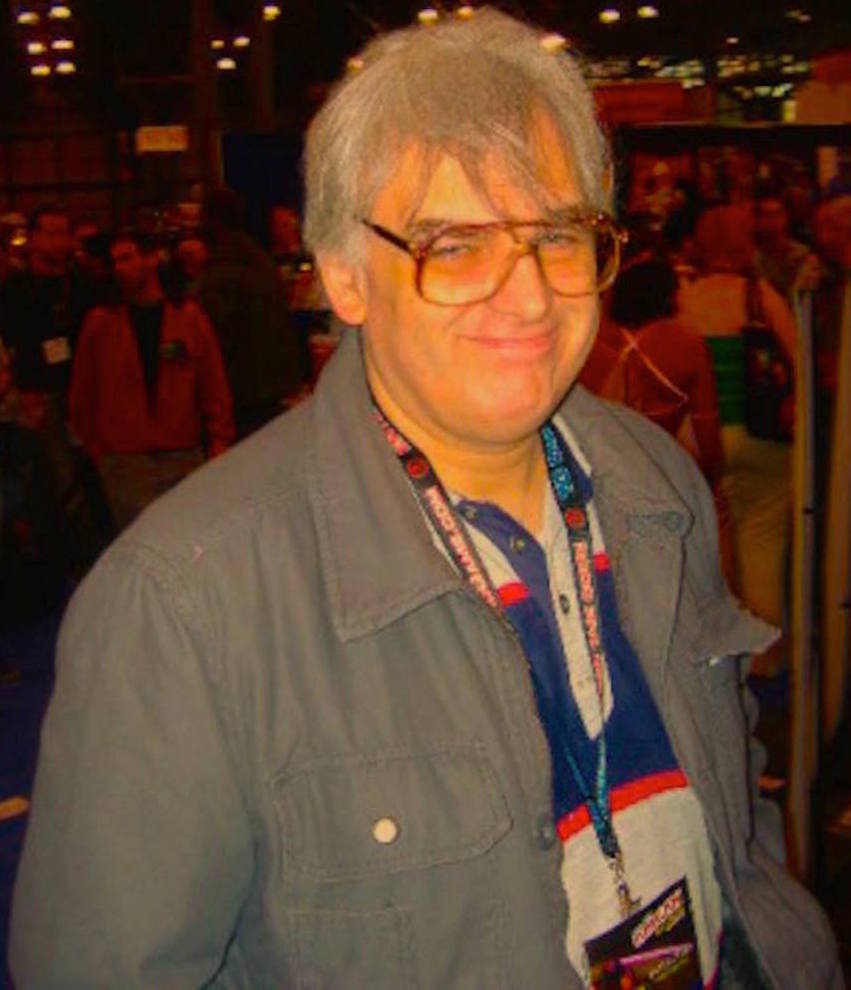
The Federation and Starfleet Command have always been at odds with The Klingon Empire. Mysterious beings known as "Organians" prevented both spacefleets from beginning an interstellar war with each other during the first season episode, "Errand of Mercy". Both fleets had been immobilized by The Organians. They were never permitted to fight again on a grand, massive scale. However, occasional incidents continually flared up between The Federation, Starfleet Command, and The Klingon Empire. Classic second and third season Star Trek episodes, "The Trouble With Tribbles" and "Day Of The Dove", chronicled these occasional incidents. This story is about one of those continual flareups.
Helmut Eppich, March 2024, LaGuardia.
“Ideas, captain? Indeed. Extreme caution.”
“Certainly, Mr. Spock. Strategic and tactical?”
“Schematic readouts of Baria Five’s asteroid field,” answered Spock, clasping hands behind his back.
Kirk nodded in agreement. Turned to Sulu and Chekov sitting and busy monitoring their combined helm and navigation consoles.
“Mr. Chekov. Display asteroid field schematics requested by Mr. Spock onto the main bridge viewing screen.”
Chekov replied dutifully, “Aye, sair. Yes, sair.”
He manipulated his navigation board instrumentation. Bleeps emitted methodically in electronic acknowledgement.
“On screen, keptin,” Chekov reported. On the main bridge viewer, its normal starfield blurred, swam, and solidified. It became a vast smattering of sugary, variously sized outline orange dots and blobs on black background.
Kirk, Spock, and bridge personnel stared unbelievingly at the visual headache. Bridge console instrumentation hummed, pinged, beeped, and whirred, seeming louder than usual.
They were interrupted by the familiar loud swishing sound of red turbolft doors snapping open. McCoy entered the bridge, looking curiously at the confusing arrangement of orange dots and blobs on the main bridge viewing screen as he stepped down next to Kirk’s command chair, hands clasped behind his back.
“One big, confounded mess,” McCoy observed.
“Certainly is, Bones,” responded Kirk. “Schematic display of Baria Five’s asteroid field.”
“It’s a wonder how ANY ship can get through there,” commented McCoy. “Much less merchant cargo ships.”
“No Klingons,” replied Kirk.
“Unlike us,” stated Spock, arms folded across his chest. “Baria Five’s large asteroid field may conceal certain hidden dangers.”
“Klingons in particular,” stated Kirk. “Battlecruisers? How many? Formation? Attack plan? Detectable in the middle of those drifting, jagged-edged, massive chunks of rock? Ambush?”
“Quite so, captain,” agreed Spock. “Asteroids may be utilized as excellently concealed assault positions.”
“At which the Klingons are experts. Couldn’t we spot Klingon ships before they attack?” asked McCoy.
“Maybe, Bones,” answered Kirk. “With that high amount of asteroids Klingon sensor readings might be very difficult because of asteroid volume, size and density.”
“We’re traveling blind,” claimed McCoy.
“The Klingons are desperate to obtain the Phoenix Medical Algae,” Spock said. “They shall risk hazardous procedures normally avoided.”
“Klingons usually go for dangerous risks,” said McCoy.
“Recommend we prepare for the same,” said Spock. “Strategically and tactically, of course.”
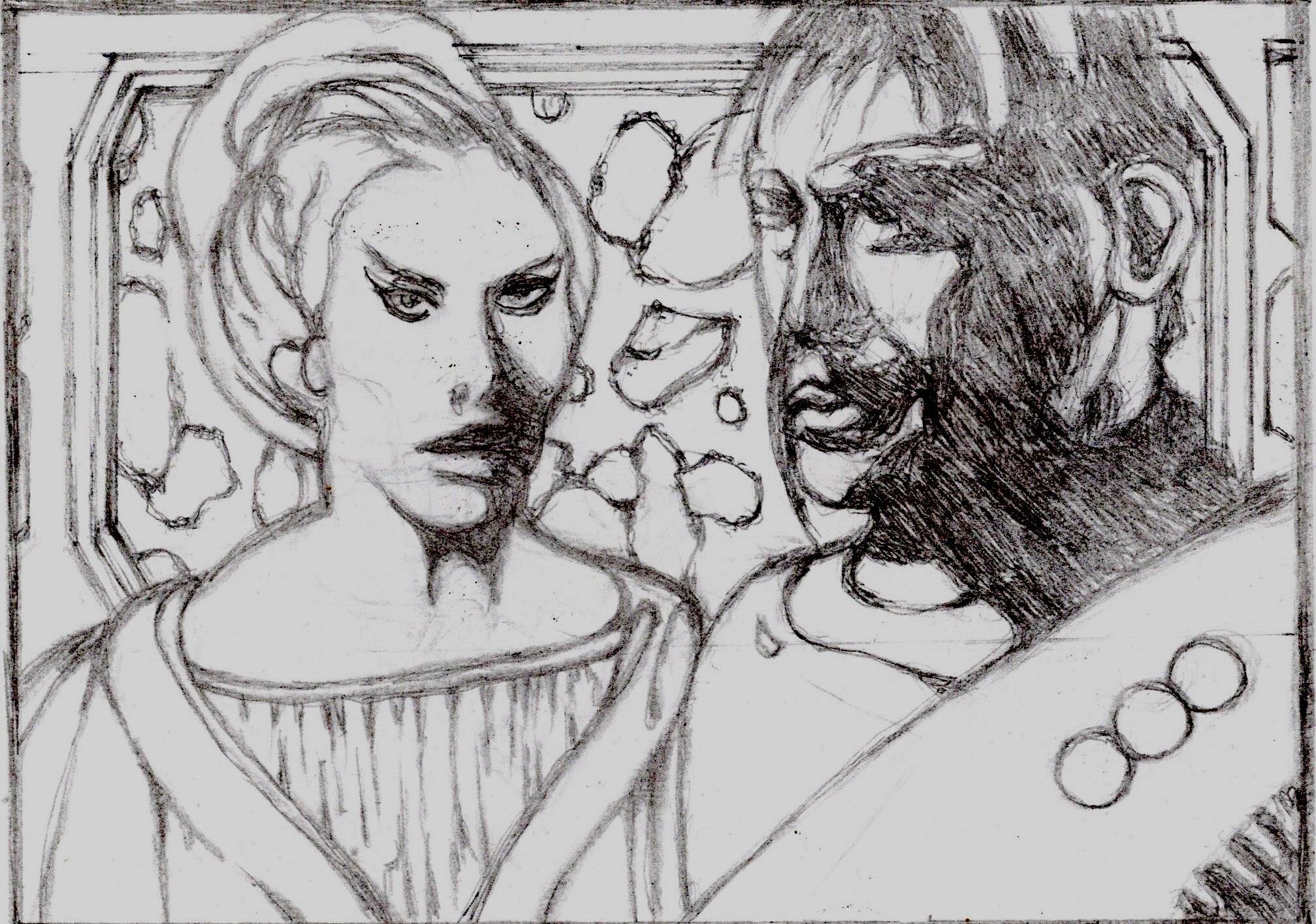 “Plea For Mercy.” Drawing by Helmut Eppich.
“Plea For Mercy.” Drawing by Helmut Eppich.
Klingon Commander Kang’s voice was deep, guttural. It sounded vicious. So was Kang. He had risen quickly through Klingon ranks as a powerful warrior in sworn duty to The Klingon Empire. No one dare refuse Kang’s orders. Or else.
“Two other Klingon battlecruisers besides ours are positioned at opposite sides of this asteroid field. We shall remain at center,” Kang’s deep gravel voice dictated. Its rough tone prompted First Commander Krit to focus his undivided attention to what Kang was saying. “Kirk will approach utilizing evasive manuevers. As would I.”
“Kirk might use these asteroids as cover for his evasive manuevers,” suggested First Commander Krit.
“Protection against our disruptor assaults. He will be difficult to track and locate amidst the asteroids. There are quite an abundance of them in numbers, sizes, and volumes.”
“Much more than “quite”. Therefore, all sensors must remain at extreme scan settings on continual optimum output,” declared Kang.
Krit nodded in acknowledgement.
“It shall be done, commander,” responded Krit. “All sensors will be increased to full power levels.”
Krit slowly studied the main black bridge viewer closely. It displayed bright red schematics of asteroids.
“Disruptors and shields as well,” added Kang. “Relay orders to other battlecruisers. Contact closest Klingon military installation for reinforcements. Kirk will undoubtedly contact a Federation starbase for reinforcements. It appears as if Commander Kor will obtain his glorious war after all.”
“Acknowledged, commander,” Krit replied faithfully. He moved through constant murky dimness to the Klingon bridge’s rear section dominated by a thick, double, combined console manned by two well-muscled Klingon officers. A continual fog blanketed the D7 Klingon battlecruiser bridge.
This contemporary D7 Klingon Battlecruiser bridge design would be the basis of an advanced bridge design currently under development evolving into the first K’tinga Class Klingon Battlecruiser. Consistent dimness enhanced red-on-black schematic data screens with control stations containing individual, triangular instrumentation on port and starboard bulkheads. Control stations were separated by inward inclining cylindrical ceiling-to-deck hull supports. Horizontal beams from rear to front of the bridge braced a low, slightly curving ceiling resting upon inclining bulkhead supports. At bridge’s rear a thick, heavy double console was manned by two Klingon soldiers. Both were backed by a bulkhead crowded with data screens. Thick, heavy, double-pocket doors bordered the bulkhead, one at each side.
Kang’s bulky throne-like control chair squatted on a dense, circular pedestal mounted at the bridge’s front and center, a metallic island amidst an ocean of rough deck grating.
In front of Kang’s control chair a Klingon helmsman and navigator sat and operated their wide console at large bridge central monitor. On it was displayed Baria Five’s asteroid field.
Kang sat in his control chair. He studied the central monitor contemplatively, brooding.
Mara, Kang’s, wife stealthily emerged from the bridge’s gloom. She approached her husband, having had hovered in the background, focusing on Kang and Krit’s conversation.
“We owe Kirk our lives,” Mara said in a low, conspiratorial voice. “He saved us from that malevolent alien feeding off our negative emotions. There is no honor to his… disposal.”
Kang’s stern gaze remained steadfastly locked on the central monitor’s image of Baria Five’s asteroid field.
“Kirk is Starfleet,” grunted Kang gruffly. “The Federation. Sworn enemies of the Klingon Empire. They are a threat to Klingon survival. And must be… dealt with…. vanquished.”
“It is not honorable for Klingons to destroy one who has aided warriors of the Klingon Empire,” pointed out Mara. “He has treated us well in cooperation with our return to The Empire.”
“Klingon honor applies not to Earthers,” growled Kang. “Klingon honor bonds Klingon warriors. Increases strength. Therefore, opposition is overcome. The Klingon Empire emerges triumphant. Victorious.”
“Opposition. Federation. Starfleet. Or….Kirk?,” questioned Mara.
“Kirk must be eradicated,” stated Kang. “A longstanding annoyance.”
“Starfleet, The Federation, and the Klingon High Command are aware of our temporary alliance with Kirk against the enemy alien.”
“Klingons fight to survive,” rumbled Kang. “The Phoenix Medical Algae will regenerate poor Klingon planetary ecosystems. Our survival rate will increase. Kirk and Starfleet will take this medical algae out of our reach, threatening Klingon survival. Our current strategy remains. If Kirk attempts an assault we shall accommodate.”
Mara stared piercingly at Kang.
“Perhaps there is something else,” she said suspiciously.
“Such as?”
“Pride.”
“Whose?”
“Yours.”
“Specify.”
“Klingon pride.”
“Extrapolate.”
“Your Klingon pride is injured. A proud Klingon warrior such as yourself aided and associated by a lowly Earther. An Earther with an honorable reputation.”
“You will not speak of this. To anyone. Ever.”
Klingon Commander Kor’s whiplike voice cracked and snapped. It cut across Paradise Pharmaceuticals’ wide expanse of tumultuous wreckage and debris splattered haphazardly in waves of jagged rubble scattered with clusters of Klingon soldiers like hungry, ravenous maggots digging through a rotting, decaying corpse lying under some hot sun.
“Leave no stone unturned!” shouted Kor. “The Phoenix Medical Algae must be found! At all costs! Failure is death!”
Kor’s footsteps clattered loudly. He approached Natalie Bianchi and Romain Senkovitch’s concealed position. A cul-de-sac.
“Shoot to wound!” yelled Kor. “Both scientists are needed alive!”
Professors Senkovitch and Bianchi were hunched over to avoid Kor’s detection as he unwittingly passed by.
Two pairs of footsteps clacked along rough tops of sharp-edged rubble over them and passed by the desperately hiding scientists. Dangerously close.
“Contact my orbiting battlecruiser!” Kor barked. “Initiate high intensity surface scans.”
“Sensor scans will be difficult to ascertain, commander,” replied an accompanying voice. “Two small life indications are easily lost amidst the massive amount of wreckage.”
“Narrow and localize sensor readings. Increase guards around the Nightingale Complex! Upon the scientists’ detection, aim to injure!” Kor instructed Krax.
“It will be done, commander,” responded Krax urgently.
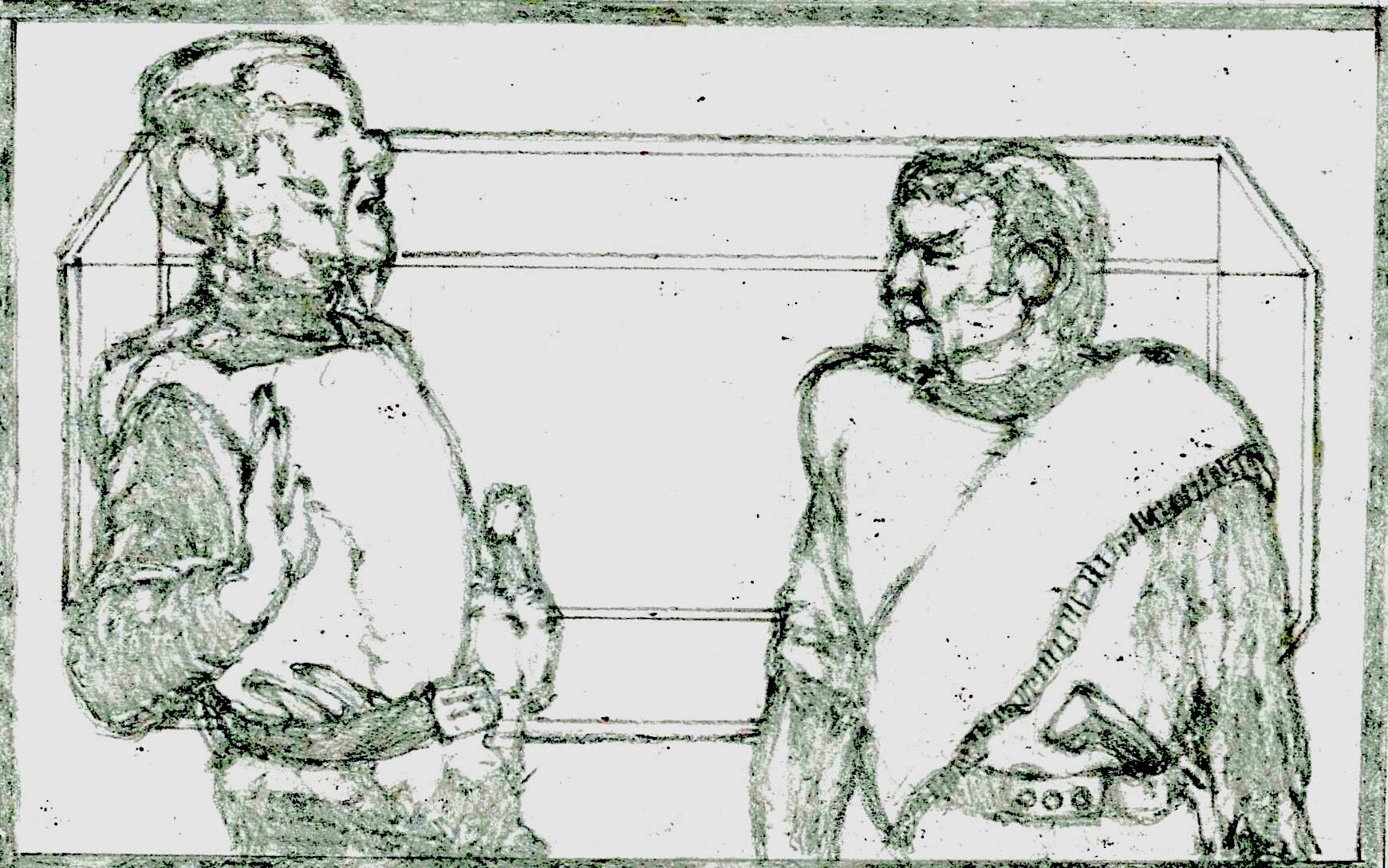 “Find Them At All Costs!” Drawing by Helmut Eppich.
“Find Them At All Costs!” Drawing by Helmut Eppich.
“Naturally,” Kor snapped. “See to it immediately.”
“Acknowledged, commander.”
“Upon apprehension bring them to me for personal interrogation. If the interrogation refuses to reveal information use our mind-sifter,” Kor ordered.
Kor and Krax’s clattering footsteps faded into the distance.
Time passed.
Both Romain Senkovitch and Natalie Bianchi remained still.
Eventually, slowly, gradually, they rose cautiously from their hunched positions. Carefully, they peered hesitantly over their cul-de-sac’s ground level edge. A low, haunting wind moaned sorrowfully over desolate, eerily tranquil surroundings, enhancing a feeling, or sense, of death.
“Something about all this….” mused Professor Bianchi. Abruptly, sudden realization showed on her face. “Of course! We’ve overlooked something! Distracted by aggressive Klingon search parties.”
Professor Bianchi returned Professor Senkovitch’s curious look with a crafty expression of mischevious, sparkling eyes, and slightly smiling twitching lips.
“Underground maintenance tunnels,” she responded. “A subterranean network of control and regulation support systems, including electrical grids. We can reach any Paradise Pharmaceutical section safely. Faster than any Klingon contingent.”
“No more getting shot from hills of debris,” stated Professor Sennkovitch. “No treacherous gauntlets.”
“We’re scientists. Not espionage operatives or athletes,” stated Professor Bianchi.
She looked around their lonely surroundings carefully. Crooked, towering, grotesquely twisted, charred, skeletal support beams loomed over them. Their jagged edges lopsidedly cutting skyward.
“We have no choice,” claimed Professor Bianchi. She continued her slow, melancholy sweep of mountainous carnage. “We must return to the Nightingale Laboratory. Locate The Phoenix Medical Algae consignment before Commander Kor apprehends it. And us.”
“IF we reach it,” Professor Senkovitch emphasized. “Those maintenance tunnels. Hopefully they’re navigable. Survived Klingon attacks.”
“Should be,” Professor Bianchi said. “They are deep enough to withstand bombardment.”
“Probably reinforced with heavy concrete and thick steel,” commented Professor Senkovitch.
“Where to next?” asked Professor Bianchi.
“Closest maintenance tunnel entrance.”
“Wherever THAT is.”
“Everything looks the same,” Professor Senkovitch observed. “No points of reference.”
“Landmarks?” queried Professor Bianchi.
“No idea,” said Professor Senkovitch. He began clambering up and out of their cul-de-sac.
“Neither have I,” Professor Bianchi remarked as she followed Professor Senkovitch.
They had practically straightened to check their surroundings when green disruptor bolts pounded bits of debris at their feet.
Both professors scrambled in one direction. Green disruptor bolts pelted a trail of shots into the ground directly behind them as they ran.
“Run zigzag!” Professor Senkovitch shouted.
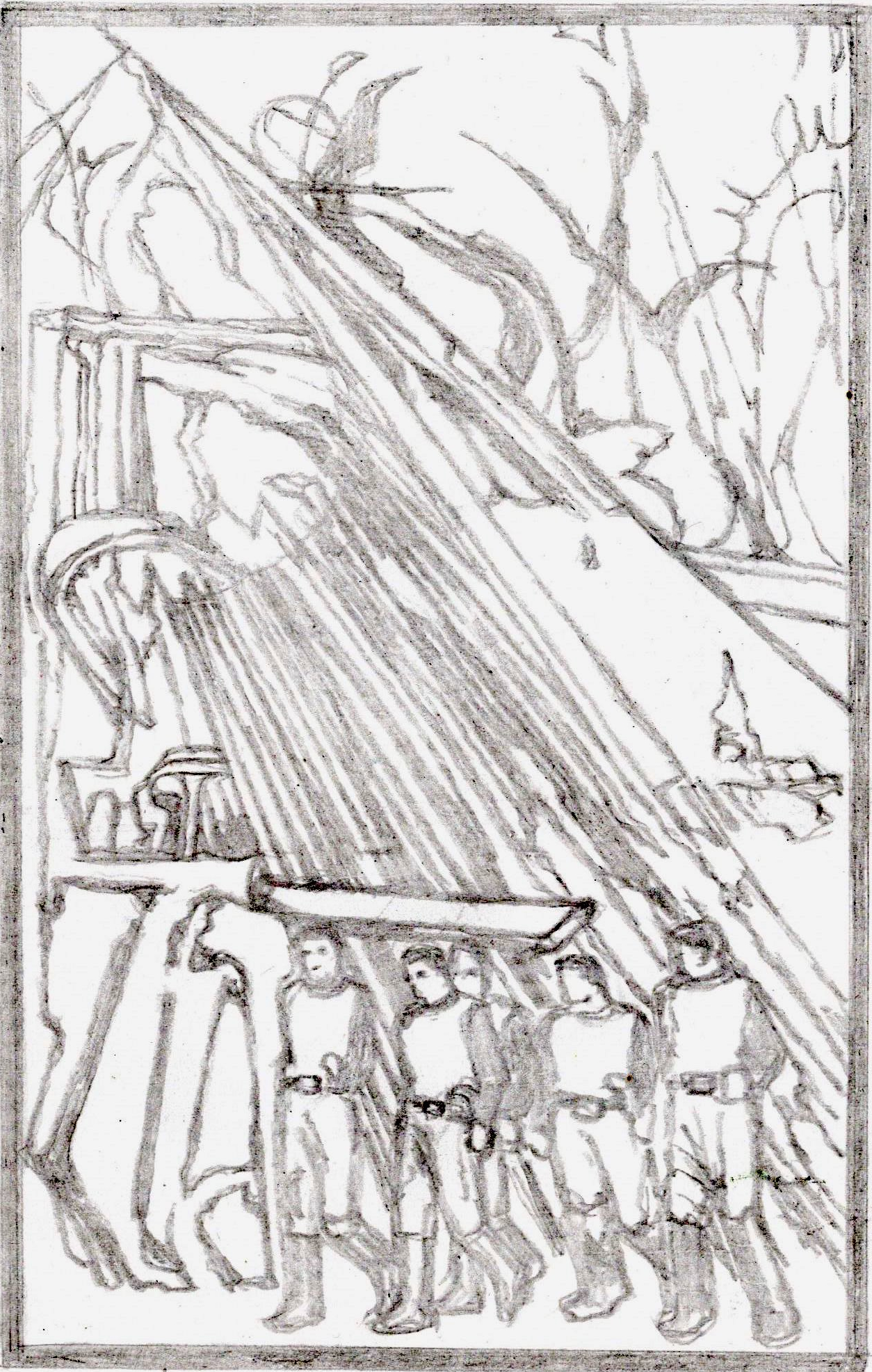 “Searching For Their Quarry.” Drawing by Helmut Eppich.
“Searching For Their Quarry.” Drawing by Helmut Eppich.
“Harder to get hit!” Professor Bianchi yelled.
Both scientists weaved back and forth, desperately running along bizarre paths through wreckage as green disruptor bolts cracked small mounds of rubble around their legs and feet.
“Thought Kor and his search parties left,” panted Professor Bianchi.
“Thought we didn’t have to run gauntlets anymore,” huffed Professor Senkovitch.
He scooped up a long, cylindrical rod from a debris pile as he ran. Next, a warped metallic rectangular panel. Tossed the long, cylindrical rod to Professor Bianchi.
“You might need this!”
Professor Senkovitch covered both of them with his large metallic, rectangular panel. A barrage of green disruptor bolts bounced off its rough surface.
Professor Bianchi suddenly ran in a different direction.
“Quick! Over here!” exclaimed Professor Bianchi. “I think this is one of the maintenance tunnel entrances.”
She stopped next to a six foot concrete, round, waist-high circular structure littered with debris.
“Knew I was right. An entrance to underground maintenance tunnels!” she claimed, knocking chunks of rubble from the grille with her rod. Flung them away.
“Said you weren’t familiar with maintenance tunnel entrances,” said Professor Senkovitch.
“I just remembered,” replied Professor Bianchi wryly.
Professor Senkovitch focused on sweeping dirt from the circular grille. Dirt filled spaces between circular edges of grillework and framing round cement support structure edges.
“Dig the rod into and around the edges,” instructed Professor Senkovitch.
“We’ll push down and tip up to open!” added Professor Bianchi.
Professor Senkovitch flung away his metallic, rectangular panel. They were out of the line of fire.
Struggling, straining, both professors dug into the grillework of its circular cover. Professor Binachi, with her rod, applied one final simultaneous push, and popped up the circular grillework cover. Large, thick clouds of dust erupted from the filthy opening.
Both scientists coughed, waved, and fanned the dust cloud surrounding their faces. It dispersed slowly, leaving a secondary layer of dust on their coveralls.
Professor Senkovitch and Professor Bianchi traded uncertain looks, apprehensive looks.
“They could not simply have vanished,” Kor mused. “Search parties have covered every crevice. All possible areas have been…”
Kor frustratingly tore through a new pile of plastic blueprint flimsies.
“Commander Kor! Observe!”
At the Baria Five Communications Center Commander Kor turned and faced one of the three Klingon soldiers sitting in front of their long, thin, rectangular consoles positioned directly below corresponding, hanging globular monitors.
Kor and Krax pivoted around to stand behind their Klingon subordinate who had called for Kor’s attention. They all stared up at the central dangling large ball-shaped monitor screen. The round monitor screen displayed a Klingon search party surrounding a circular, concrete grating which rose six feet from cluttered ground. The grating looked to be six feet wide. It was also quite heavy. The Klingon soldiers struggled and managed to heave the circular grating clear of its yawning, round cement entrance.
Kor whirled irritably back to the ever faithful chart table overflowing with familiar plastic, thin, transparent flimsies. He dug desperately through disarrayed files. Kor frustratingly flung flimsies about, grunting angrily.
Krax maintained his attention sharply on the center globular monitor’s screen, suddenly expressing puzzlement. Then, slowly, puzzlement slid into recognition.
Kor finally settled on one particular flimsy which had inadvertantly caught his attention. He scrutinized it intensely. An urgent frown grew on his brow.
“Location established!” Kor exclaimed triumphantly. ”These sets of plans indicate subterranean maintenance tunnels!”
Krax joined Kor at the chart table. He ran a look of concentration over the flimsies.
“Both scientists can travel anywhere under this entire installation,” observed Krax. “Quick enough to evade our search parties. And most importantly, evade capture.”
Kor absently tapped the transparent blueprint flimsy. His sinister face grew a malicious grin across his devilish features.
“On the contrary, invasion parties will only hamper each other’s efforts,” stated Kor. “And provide both scientists cover and rapid escape. Also, we are unsure of the underground maintenance tunnels’ stability due to our assault. Their current condition is unknown.”
“Our disruptor bombardments could have inadvertently damaged them,” suggested Krax. “Some portions may be impassable.”
“Precisely,” Kor grunted. His malevolent face turned to Krax. “We will allow both scientists to unwittingly deliver themselves into our waiting hands from their inevitable appearance at the Nightingale laboratory from the nearest maintenance tunnel entrance closest to the Nightingale Laboratory complex.”
Kor moved to the trio of globular monitors and looked up at the central monitor. Victory glowed on his leering face. He nodded expectantly. The Klingon party which had uncovered the maintenance tunnel opening were listening to their communicators instead of climbing down into the dark, murky depths of blackness lurking beneath the round open access grating.
“Execution?” questioned Krax.
Kor paced back and forth in front of the chart table with overflowing flimsies.
“Our forces will conceal themselves to prepare for both scientists’ appearance,” said Kor. “They will assume the Nightingale Laboratory is free of Klingon surveillance. They will thoroughly, vigilantly, search for their precious Phoenix Medical consignment. We shall strike when both scientists have found their Phoenix Medical Algae consignment.”
“Prisoners?” asked Krax.
“Prisoners. Hostages. Indeed so,” Kor agreed. “Bargaining power. Particularly when our mind-sifter is involved.”
Kor grinned maliciously, malevolently.
“Strategic and tactical, Spock?” asked Kirk. “Dangerous risks. Any ideas?”
Spock raised a satanic eyebrow.
“Extreme caution, sir. As I’ve mentioned before.”
“Sarcasm, Spock?” asked McCoy wryly.
“Sarcasm would never occur to me in a situation such as this, doctor,” said Spock.
“Oh really?”
Spock clasped hands behind his back.
“Baria Five’s asteroid field is extremely dense. And extremely dangerous. Asteroid surfaces are composed of hazardous sharp-edged outcroppings with endless diversities of volume, mass, and densities capable of ripping open any space vessel attempting transversal.”
Kirk added, “Especially cargo ships delivering supplies to the Paradise Pharmaceutical medicinal complex on Baria Five which lies at the opposite end of this asteroid field.”
Kirk gestured at the asteroid schematics on the main bridge viewing screen.
“If supply cargo ships continuously, safely, reach Baria Five with supplies they have to be extremely careful.”
Spock nodded assuredly. “Indeed, captain. A logical conclusion, although I believe I have already mentioned that a moment ago.”
“This is getting worse the more we talk about it,” McCoy commented.
Kirk moved to the red bridge railing section in front of Spock’s library computer station. Leaned on it with both hands and faced his Vulcan first officer.
“Is there information in your computer banks containing courses used by Baria Five cargo transport ships?” asked Kirk.
“They all could use different routes through Baria Five’s asteroid field,” joined in McCoy. “An endless amount. Depends on type of ship and her captain.”
Spock hunched over his hooded viewer. His left hand adjusted the hooded sensor viewer’s silver, round tuning knob.
Kirk straightened. Turned forward to face the main bridge viewing screen. One hand lingered on the red bridge railing section. He stared piercingly at the bridge screen displaying asteroid field schematics.
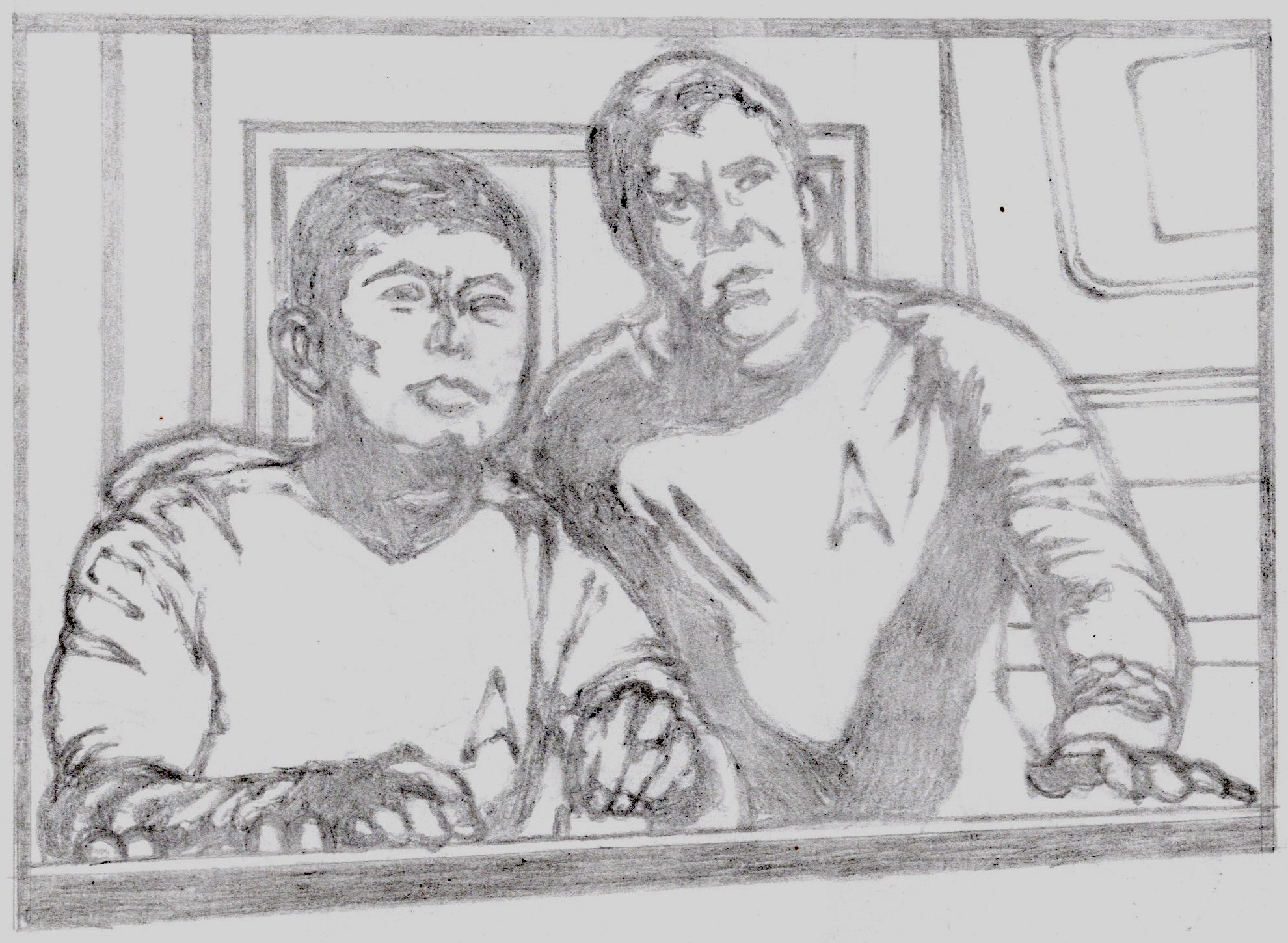 “Maintain a sharp eye, Mr. Sulu.” Drawing by Helmut Eppich.
“Maintain a sharp eye, Mr. Sulu.” Drawing by Helmut Eppich.
“We must keep a sharp eye out for Klingon ships inside the asteroid field,” Kirk stated.
“These courses are safest traveled by Baria Five cargo vessels and other types of transport ships,” explained Spock.
“Those safe courses are also insane,” declared McCoy. He narrowed his eyes slightly. Clasped hands behind his back. Leaned forward a bit.
Spock stood before his library computer console, right hand resting on the hooded sensor viewer.
“Nevertheless, those courses are considered to represent the safest passage through the asteroid field by various ships.”
Kirk nodded satisfactorily.
“Very well. Could Klingon ships be lurking somewhere along, or at the end, of those routes?”
“Anywhere, captain,” replied Spock. “Klingons are not intimidated by desperate measures. They welcome extreme challenges involving valuable objects as The Phoenix Medical Algae.”
“Inside the asteroid field?”
“It offers excellently concealed assault positions,” answered Spock. “Klingons are bold. Aggressive. They risk ships and crew. Their ships would be difficult for detection amidst multitudes of various asteroid densities. Sensor scans may be avoided by moving extremely close to asteroid surfaces.”
“Perfect cover,” snorted McCoy. “For us and them. We can pull the same shannigans as they can.”
“They’ll be in concealed positions anywhere in or on the outer fringes of Baria Five’s asteroid field,” Kirk said. He continued looking thoughtfully at the main bridge viewing screen. “McCoy has a point. We can use that same method of cover for our protection as well as attack positions.”
“Indeed so, captain,” Spock said.
“What are you going to do, Jim?’ asked McCoy.
“That one course of action may help us,” Kirk replied, returning to his command chair.
Standing on its right side, opposite McCoy, he pressed the armrest’s intercom.
“Kirk to engineering. Sorry, Scotty. We’re going to need warp power after all,” Kirk said. “Stand by on auxiliary power as well. It might come handy during tight spots.”
“Aye, sair,” Scott’s voice replied dourly. “Expected it. Used to it by now. I’ll gi’ye whatever amount of power ye need. If I can.”
Kirk smiled slightly.
“Very good, Scotty. Kirk out.” He sat in the command chair. “Mr. Sulu. Ahead warp factor one. Stay on those phaser banks and deflector shields.”
“Yes, sir,” the Asian helmsman replied dutifully. His agile fingers scrambled over multi-colored, jewel-like buttons and switches on his panel, emitting melodic bleeps.
In the background a deep, low, rumbling hum escalated into a thundering rumble which rose to a high-pitched crescendo and faded out of existence.
“Warp factor one, captain,” stated Sulu.
“Zig-zag manuevers. It’s essential we be a very difficult target.”
“Yes, sir,” replied Sulu with a satisfied grin.
“Mr. Chekov. Ride herd on those photon torpedos. We’ll need them.”
“Wurry goot, sair,” replied the young Russian navigator. He flipped different colored switches and pushed gleaming, jewel-like buttons. The navigation console warbled efficiently.
“What do you have in mind, Jim?”
“A long, fast dash across open space on our approach to the asteroid field with possible high speed Klingon attacks. If we survive and make it to the asteroid field, a very involved game of hide and seek.”